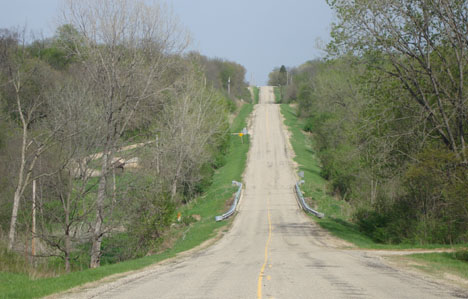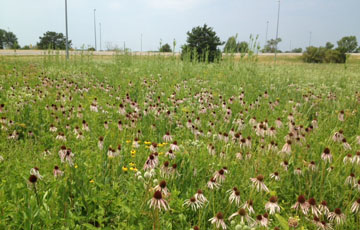May 2014

Peoria County has begun a reduced mowing program this year along some of its roadways. Nearly 32 miles in nine different locations have been chosen in an effort to enhance native plant habitat that will help support central Illinois pollinators such as honeybees, monarch butterflies, moths, native bees, insects and hummingbirds. Pollinators are extremely important to the success of natural plant communities and our local farms. This multi-year program will measure the impact of this change and gradually expand to cover much of the 320 miles of roadway maintained by Peoria County.
As the program is evaluated over the next several years it may expand to include not just more county right-of-way but also native landscape seeding and planting. One of the best ways to imagine what the future of these areas may become is to travel the Brimfield-Princeville road that goes through Jubilee State Park. In this area the Prairie Dawg volunteer group has established a native plant area in one section, near Savage Road, that after nearly ten years of work is now filled with healthy native plants and pollinators in the summer.
This Sierra Club sponsored initiative may be one of the first in Illinois but it is a very common practice in Iowa where over three dozen counties have established programs. Check out information from the University of Northern Iowa on Integrated Roadside Vegetation Management.
PEORIA COUNTY SUSTAINABILITY PLAN
Reduced highway mowing is one of the initiatives promoted in the Peoria County Sustainability Plan of 2010. Promoted by the Global Warming Solutions Group and Peoria Families Against Toxic Waste, it is a committment to engage in pollution prevention activities and to develop and promote practices that maximize beneficial effects on the environment. The Sustainability Plan encourages specific performance measures. It is divided into the areas of Solid Waste, Employees, Purchasing, Land Use, Operations, Building and Construction. Among its accomplishments to date are many energy efficiency efforts, reduced pollution, native plantings, environmental purchasing, improved demolition practices, new building materials, lighting upgrades and support for two new LEED buildings,the Riverfront Museum and Headington Oaks senior living facility.
LOCATION
Here is the list of areas that will experience some kind of reduced mowing in 2014:
- Kickapoo Creek Road, R51, from Pottstown Bridge to Bartonville. 4 miles, both sides.
- Taylor Road, R 40, from Goetz Road to Route 8, 1.8 miles, both sides.
- Truitt Road, R 53, from Allen Road east to Chillicothe City limits. 5 miles, both sides.
- Richwoods Road, D 43, from Route 8 east to Peoria City Limits. 0.5 miles, both sides.
- Brimfield Jubilee Rd. D29, from Maher Road east to Princeville Jubilee Rd, 5 miles, both sides.
- Savage Rd , R29, from Brimfield Jubilee Rd north to Parks School Rd, 2.4 miles, both sides.
- Maher Road, D25, from Forney Road north to Parks School Road, 0.5 miles, both sides.
- N. Princeville Jubilee Rd, R40, from Akron Rd north to Princeville City Limits, 1.5 miles, both sides.
- Laura Road, D20, from Elmore Road east to Daily Road, 7.5 miles, both sides.
- Koerner Trigger Road, R47, from Route 8 north to Route 150, 3 miles, both sides.
Ten locations, 31.2 miles, both sides of all roads, approximately 9% of total county roadway.
ALL roadways will be mowed once early this spring, one mower width each side of the road, (approximately 10 feet width). Some roadways will have a net reduced mowing area of less than 25%, such as Kickapoo Creek Road, because of the narrow right-of-way and curving roads that require driver line of sight. Some roadways may have additional mowing beyond the 10 foot right-of-way, if public safety issues such as line of sight or concerns about drifting snow are present, or if adjoining landowners insist on county mowing, or if private landowners choose to mow the area themselves. Because this is the first year of this large program, monitoring of these areas will be needed to see how tall the unmowed area grows over this first season and which landowner chooses to mow county property themselves. There will not be any mowing during the main flowering season in all of the areas, from approximately May thru early September.
MEASUREMENTS
In order to understand how much of a difference reduced mowing will have, Peoria County plans to measure the following items in the pilot areas:
- Number of accidents and the official reasons determined by authorities.
- Amount of road kill, which may indicate the increased use of the reduced mowing areas by wildlife.
- Amount of pesticide actually used by Peoria County in each pilot area.
- Photographs of each pilot area during the season. Spring pictures (April & May), will be compared with Summer (late July) and Fall (mid September) pictures.
- Amount of citizen calls/complaints or compliments.
- Amount of adjoining landowner phone calls/complaints or compliments.
- Amount of mowing that actually occurs in each pilot area with approximate dates of mowing.
- Amount of area that is NOT MOWED in each pilot area.
- Any additional problems identified by county roadway staff such as drifting snow due to unmowed areas creating an undesirable snow fence.
TIMELINE
The program will need to be assessed carefully in each of these areas over several years to assess the impact of non-native aggressive weeds such as teasel and vetch. Assessments will also be needed to determine what kind of desirable native wildflower spread, if any, occurs. Some adjoining landowners may not be pleased with reduced mowing. Will there be a proliferation of native plants such as the aggressive milkweed, one of the desirable pollinator plants? Several growing seasons will be needed to establish these trends.

VOLUNTEERS NEEDED
If you are willing to use your camera or iPhone and will agree to take 4 photographs, one every few months, HOI Sierra Club would like to ask for 1 hour of your time. Volunteers will be assigned a specific location within the 31.3 miles of Peoria County reduced mowing. Their job will be to take 1 photograph of the reduced mowing area four times over the 2014 season. The dates would be approximately early May, mid to late July, early September and late October. These photographs will be digitally archived and used to evaluate the impacts of reduced mowing. A written description of each site location and suggestions for taking the picture will be available to help make all the volunteer pictures somewhat standardized in perspective. For more information or to volunteer, contact Dave Pittman at dvdpttmn@aol.com or 309-573-2354.
Even as the Monarch butterfly migration is threatened by heavy pesticide spraying and reduced habitat, the reduced mowing program offers a lifeline that may someday stretch across Peoria County, central Illinois and through other states. It is exciting to think that part of the solution to improved pollinator habitat may be as simple as letting the plants grow alongside our highways.